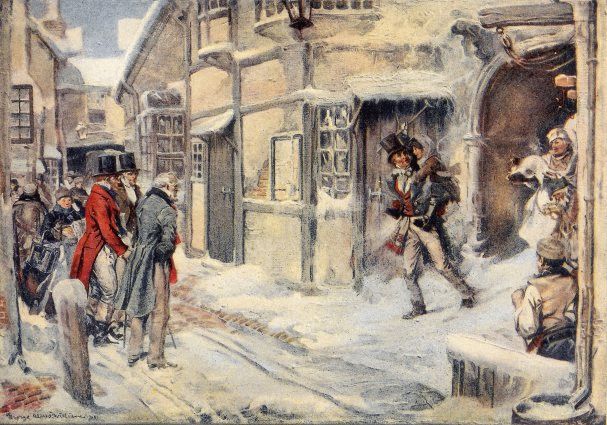[i]
A CHRISTMAS CAROL
By CHARLES DICKENS
ILLUSTRATED BY
GEORGE ALFRED WILLIAMS
New York
THE PLATT & PECK CO.
[ii]
Copyright, 1905, by The Baker & Taylor Company
[iii]
 "He had been Tim's blood horse all the way from church."
"He had been Tim's blood horse all the way from church."
INTRODUCTION
The combined qualities of the realist and the idealist
which Dickens possessed to a remarkable degree,
together with his naturally jovial attitude toward life
in general, seem to have given him a remarkably happy feeling
toward Christmas, though the privations and hardships of his
boyhood could have allowed him but little real experience with
this day of days.
Dickens gave his first formal expression to his Christmas
thoughts in his series of small books, the first of which was
the famous "Christmas Carol," the one perfect chrysolite.
The success of the book was immediate. Thackeray wrote of
it: "Who can listen to objections regarding such a book as
this? It seems to me a national benefit, and to every man
or woman who reads it, a personal kindness."
This volume was put forth in a very attractive manner,
with illustrations by John Leech, who was the first artist to make
these characters live, and his drawings were varied and spirited.
There followed upon this four others: "The Chimes,"
"The Cricket on the Hearth," "The Battle of Life," and "The
Haunted Man," with illustrations on their first appearance by
Doyle, Maclise, and others. The five are known to-day as the
"Christmas Books." Of them all the "Carol" is the best known
and loved, and "The Cricket on the Hearth," although third in
the series, is perhaps next in point of popularity, and is especially
familiar to Americans through Joseph Jefferson's
characterisation of Caleb Plummer.
Dickens seems to have put his whole self into these glowing
little stories. Whoever sees but a clever ghost story in the[iv]
"Christmas Carol" misses its chief charm and lesson, for there
is a different meaning in the movements of Scrooge and his
attendant spirits. A new life is brought to Scrooge when he,
"running to his window, opened it and put out his head. No
fog, no mist; clear, bright, jovial, stirring cold; cold, piping for
the blood to dance to; Golden sun-light; Heavenly sky; sweet
fresh air; merry bells. Oh, glorious! Glorious!" All this
brightness has its attendant shadow, and deep from the childish
heart comes that true note of pathos, the ever memorable
toast of Tiny Tim, "God bless Us, Every One!" "The Cricket
on the Hearth" strikes a different note. Charmingly, poetically,
the sweet chirping of the little cricket is associated with
human feelings and actions, and at the crisis of the story decides
the fate and fortune of the carrier and his wife.
Dickens's greatest gift was characterization, and no English
writer, save Shakespeare, has drawn so many and so varied
characters. It would be as absurd to interpret all of these as
caricatures as to deny Dickens his great and varied powers
of creation. Dickens exaggerated many of his comic and satirical
characters, as was his right, for caricature and satire are
very closely related, while exaggeration is the very essence of
comedy. But there remains a host of characters marked by
humour and pathos. Yet the pictorial presentation of Dickens's
characters has ever tended toward the grotesque. The interpretations
in this volume aim to eliminate the grosser phases
of the caricature in favour of the more human. If the interpretations
seem novel, if Scrooge be not as he has been pictured,
it is because a more human Scrooge was desired—a
Scrooge not wholly bad, a Scrooge of a better heart, a Scrooge
to whom the resurrection described in this story was possible.
It has been the illustrator's whole aim to make these people
live in some form more fully consistent with their types.
George Alfred Williams.
Chatham, N.J.
[v]
CONTENTS
| STAVE | PAGE |
|---|
| I | Marley's Ghost | 11 |
| II | The First of the Three Spirits | 32 |
| III | The Second of the Three Spirits | 51 |
| IV | The Last of the Spirits | 76 |
| V | The End of it | 93 |
[vi]
ILLUSTRATIONS
|
"He had been Tim's blood horse all the way from church."
|
Frontispiece
|
|
"A Merry Christmas, Uncle! God save you!" cried a cheerful voice.
|
14
|
|
To sit staring at those fixed glazed eyes in silence, for a moment,
would play, Scrooge felt, the very deuce with him.
|
26
|
|
"You recollect the way?" inquired the spirit. "Remember it!" cried
Scrooge, with fervour; "I could walk it blindfold."
|
36
|
|
"Why, it's Ali Baba!" Scrooge exclaimed in ecstasy. "It's dear old
honest Ali Baba!"
|
38
|
[11]
Top
Stave I
Stave II
Stave III
Stave IV
Stave V















